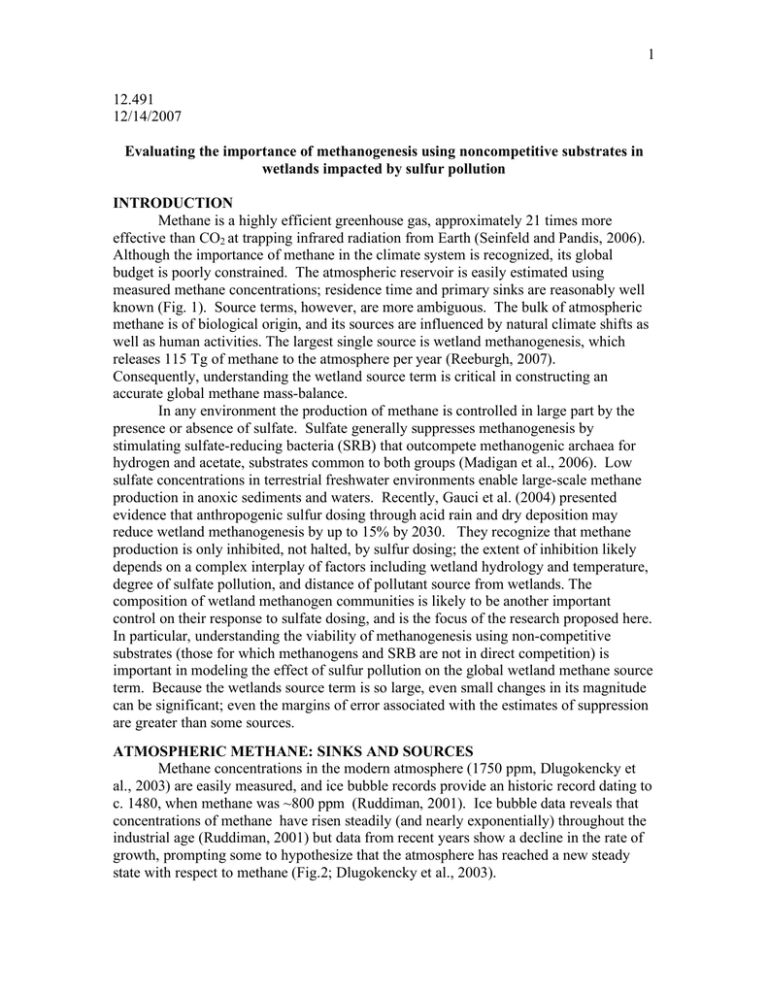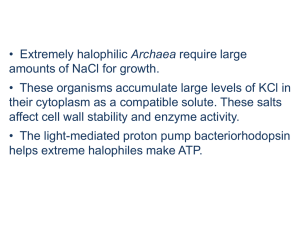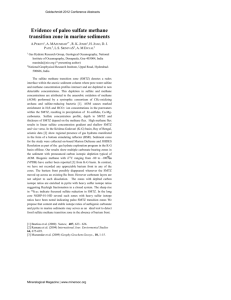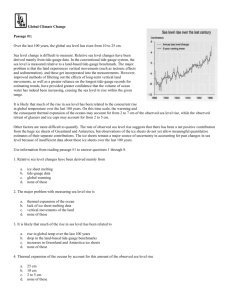1 12.491 12/14/2007 Evaluating the importance of methanogenesis using noncompetitive substrates in
advertisement

1 12.491 12/14/2007 Evaluating the importance of methanogenesis using noncompetitive substrates in wetlands impacted by sulfur pollution INTRODUCTION Methane is a highly efficient greenhouse gas, approximately 21 times more effective than CO2 at trapping infrared radiation from Earth (Seinfeld and Pandis, 2006). Although the importance of methane in the climate system is recognized, its global budget is poorly constrained. The atmospheric reservoir is easily estimated using measured methane concentrations; residence time and primary sinks are reasonably well known (Fig. 1). Source terms, however, are more ambiguous. The bulk of atmospheric methane is of biological origin, and its sources are influenced by natural climate shifts as well as human activities. The largest single source is wetland methanogenesis, which releases 115 Tg of methane to the atmosphere per year (Reeburgh, 2007). Consequently, understanding the wetland source term is critical in constructing an accurate global methane mass-balance. In any environment the production of methane is controlled in large part by the presence or absence of sulfate. Sulfate generally suppresses methanogenesis by stimulating sulfate-reducing bacteria (SRB) that outcompete methanogenic archaea for hydrogen and acetate, substrates common to both groups (Madigan et al., 2006). Low sulfate concentrations in terrestrial freshwater environments enable large-scale methane production in anoxic sediments and waters. Recently, Gauci et al. (2004) presented evidence that anthropogenic sulfur dosing through acid rain and dry deposition may reduce wetland methanogenesis by up to 15% by 2030. They recognize that methane production is only inhibited, not halted, by sulfur dosing; the extent of inhibition likely depends on a complex interplay of factors including wetland hydrology and temperature, degree of sulfate pollution, and distance of pollutant source from wetlands. The composition of wetland methanogen communities is likely to be another important control on their response to sulfate dosing, and is the focus of the research proposed here. In particular, understanding the viability of methanogenesis using non-competitive substrates (those for which methanogens and SRB are not in direct competition) is important in modeling the effect of sulfur pollution on the global wetland methane source term. Because the wetlands source term is so large, even small changes in its magnitude can be significant; even the margins of error associated with the estimates of suppression are greater than some sources. ATMOSPHERIC METHANE: SINKS AND SOURCES Methane concentrations in the modern atmosphere (1750 ppm, Dlugokencky et al., 2003) are easily measured, and ice bubble records provide an historic record dating to c. 1480, when methane was ~800 ppm (Ruddiman, 2001). Ice bubble data reveals that concentrations of methane have risen steadily (and nearly exponentially) throughout the industrial age (Ruddiman, 2001) but data from recent years show a decline in the rate of growth, prompting some to hypothesize that the atmosphere has reached a new steady state with respect to methane (Fig.2; Dlugokencky et al., 2003). 2 The primary atmospheric sink for methane is reaction with OH· radicals in the troposphere, although a lesser amount is oxidized in the stratosphere, and some reacts with Cl· to form CH3Cl (Seinfeld and Pandis, 2006). Sources of methane to the atmosphere are more difficult to constrain. Major anthropogenic contributions include fermentation in landfills, waste treatment facilities and livestock guts; rice cultivation; fossil fuels, and release during coal mining (IPCC, 2007). Fermentation in termite guts, dissociation of clathrates, and an enigmatic marine source each account for 5-12% of natural emissions; the remaining 76% is attributed to wetlands sources (IPCC, 2007). Estimated fluxes of methane to the atmosphere (Reeburgh, 2007) are shown in Figure 1. Figure 1: major sources (black arrows) and sinks (red arrows) of atmospheric methane (data from Reeburgh, 2007). 3 Figure 2: Atmospheric methane concentrations, 1984-2004; the rate of increase has dropped to near zero, suggesting that the atmosphere may have reached a new steady state with respect to methane. (Data from Dlugokencky et al., 2003.) SULFUR POLLUTION AND WETLAND METHANOGENESIS Most freshwater systems are sulfate-limited (Drever, 1998), receiving the bulk of their sulfate from atmospheric deposition (Gauci et al, 2004). Natural and industrial activities introduce sulfur dioxide to the atmosphere where it is converted to sulfuric acid, likely through the following radical reactions (Seinfeld and Pandis, 2006), and then deposited through precipitation or dry deposition. (1) SO2 +OH· • HOSO2· (2) HOSO2· + O2 • HO2· + SO3 (3) SO3 + H2O • H2SO4 Natural sources include volcanism and dimethylsulfide produced by plankton; these are small in comparison to the anthropogenic contribution (coal plants, industry). Environmental regulations have reduced sulfur emissions in the United States and Europe, but countries with developing industries continue to increase emissions. Gauci et al. (2004) examined the effect of sulfur pollution on peatland methanogenesis through field experiments and modeling. Peat columns from the United States and Europe were amended with sulfate in concentrations and timing intended to mimic sulfate deposition by acid rain; a range of 10-150 kg SO42- S hectare-1year-1 was used. Methane emissions were suppressed from 12-45% and a threshold level of <15 kg SO42- S hectare-1 year-1 was defined as sulfate limitation. Sulfur deposition was simulated using the Goddard Institute for Space Studies General Circulation Model (GISS GCM) for the years 1960-2080. Combining field estimates of sulfur-induced inhibition of methanogenesis with modeled deposition, Gauci et al. (2004) concluded that sulfur pollution in the 20th century may have reduced methanogenesis to preindustrial levels; additionally, cleaner technologies will reduce future sulfur pollution and are predicted to cause a 15% enhancement of wetland methanogenesis between 2030-2080. 4 PATHWAYS OF METHANOGENESIS There are several known pathways of methanogenesis, all of which are exclusive to the Archaeal kingdom Euryarchaeota (Madigan, 2006). CO2 reduction and acetate fermentation can be summarized by equations 4 and 5, respectively (Madigan, 2006). (4) CO2 + 4 H2 → CH4 + 2H2O (5) CH3COOH → CH4 + CO2 These two processes are inhibited by the presence of sulfate because sulfate supports the growth of SRB, which have a higher substrate affinity for H2 and CH3COOH than methanogens have (Madigan et al., 2006). A third type of methanogenesis occurs in some archaea that are able to use other substrates, including including formic acid, methanol, methylamines, dimethyl sulfide, and methanethiols. Termed noncompetitive substrates, these compounds are at best weakly utilized by bacteria and other archaea. Notably, rates of methanogenesis on noncompetitive substrates have been observed to drop in the absence of sulfate (Oremland, 1982); this suggests that at least a portion of the archaeal community in wetlands is capable of switching from one type of substrate to another. PROPOSED RESEARCH Sulfate-dosing studies (Gauci et al., 2004) have demonstrated that significant inhibition of methanogenesis can occur above 15 kg SO42- S hectare-1 year-1. These studies, though detailed, are purely empirical (e.g., Granberg et al., 2001) in that they rely on measurements of methane emissions but do not consider changes in mechanisms of methane production. Communities of methanogenic archaea may not be uniform between wetlands, and differences may lead to variations in response to sulfate. To refine the field-based estimates (and, ultimately, the predictions that are based on them), it is necessary to determine whether methanogens present have the capacity to switch from competitive to noncompetitive substrates. Dosing studies have not, to present, included microbial community characterization. If wetlands studied have low numbers of archaea that are able to use noncompetitive substrates, methanogenesis will be suppressed to a greater extent than if these archaea are present. Members of the genus Methanosarcina, Methanomicrobium and Methanobacterium are of primary interest because they have been shown capable of using H2 and noncompetitive substrates. Availability of non-competitive substrates: The first goal is to determine whether noncompetitive substrates are available in low-nutrient, ombrotrophic wetlands (those receiving nutrients primarily from precipitation and dry deposition, and thus most sensitive to sulfur pollution). Although these are low nutrient settings, some vascular plants in wetlands release small organic compounds from their submerged roots, introducing a potential substrate for methanogenesis directly to the suboxic zone. Representative peatlands across North America, northern Europe (selected by Gauci et al., 2004) and Asia will be sampled, and concentrations of methylamine, methanethiol, methanol, and dimethyl sulfide will be determined using gas chromatography-mass spectrometry with flame ionization detector. Microbial community profiling: Phylogenetic surveys of methanogens active in representative wetlands will determine the composition of the existing community. Nucleic acids will be extracted from filtered water and sediment underlying anoxic water columns, and 16s rRNA will be amplified using Archaea-specific primers and sequenced. 5 In addition, gene expression (“transcriptomics”) studies will analyze messenger RNA to determine whether enzymes specific to different types of methanogenesis are actively being produced and with which archaeal phyla they are associated.. Specifically, genes targeted will be those encoding for coenzyme M, F430 and HS-HTP (all unique to methanogens; White, 2007) and DMSP lyase, necessary for methanogenic growth on DMSP. Incubation studies: Several relevant, unresolved questions about methanogenesis can be addressed in this study. Do different pathways of methanogenesis commonly coexist in an environment (e.g., ?), and does non-competitive substrate usage increases when CO2 reduction and aceticlastic methanogenesis are inhibited by sulfate? Incubation experiments using peat cores and 13C labeled substrates will address these issues and determine rates of methanogenesis and substrate uptake. Levels of labeled methanol, methanethiol, DMSP, and methylamine (at a range of natural concentrations) will be maintained in peat columns periods up to one year. Incorporation of the label into archaeal lipids pentamethylicosane (PMI), archaeol and hydroxyarchaeol (fig. 3), considered diagnostic for methanogens (Peters, 2005), will be traced by compound-specific isotope analysis. DNA extraction and separation via cesium chloride density centrifugation will resolve labeled from unlabeled DNA; labeled 16S ribosomal DNA will then be cloned and sequenced (Radajewski, 2000). It will then be possible to determine which (if any) methanogens are actively using the labeled substrate. Any methane emitted will be trapped in headspace containers and measured periodically throughout the course of the incubation in order to determine rates of methanogenesis from both competitive (unlabeled) and non-competitive (labeled) substrates using an isotope mass balance approach. These incubations, with and without sulfate amendments, can be coupled with transcriptomics to develop a more mechanistic picture of community methanogenesis – and its response to sulfate addition - in representative wetlands. Longer term (years) incubations will reveal whether communities of methanogens initially poor at utilizing noncompetitive substrates will improve, either by changes in archaeal species present or by adaptations. a. PMI b. archaeol c. hydroxyarchaeol Figure 3: a. 2,6,10,15,19-pentamethylicosane (PMI; Peters, 2005), b. archaeol, c. sn-3 hydroxyarchaeol hydroxyarchaeol: core membrane lipids of methanogens (b-c, Werne et al., 2003). SUMMARY Tracer incubations and field measurements described above will provide the data required to evaluate whether methanogenesis using noncompetitive substrates is significant in wetlands impacted by sulfur pollution. Rates of methanogenesis under different degrees of sulfate addition will be determined and compared to gene expression, 6 with the ultimate goal of understanding how community shifts influence net methanogenesis from northern wetlands. A stronger understanding of how these processes work at a microbial level is required to improve predictions about the response of complex but globally significant wetland environments to changes in sulfur pollution. REFERENCES Dlugokencky, E.J., Houweling, S., Bruhwiler, L., Masarie, K.A., Lang, P.M., Miller, J.B., and Tans, P.P., 2003, Atmospheric methane levels off: Temporary pause or a new steady-state? Geophyscial Research Letters, v. 30, doi: 10.1029/2003GL018126. Drever, J., 1998, The geochemistry of natural waters, Upper Saddle River, NJ: Prentice Hall, 436 p. Gauci, V., Matthews, E., Dise, N., Walter, B., Koch, D., Granberg, G., and Vile, M., 2004, Sulfur pollution suppression of the wetland methane source in the 20th and 21st centuries: PNAS, vol. 101, p. 12583-12587. Granberg, G., Sundh, L., Svensson, B., and Nilsson, M., 2001, Effects of temperature, and nitrogen and sulfur deposition, on methane emission from a boreal mire, v. 82, p. 1982-1988. Intergovernmental Panel on Climate Change, 2007, Fourth Assessment Report, retrieved from http://www.ipcc.ch/ipccreports/special-reports.htm 11/26/07. Madigan, M., Martinko, J.M., Dunlap, P., Clark, D.P., 2006, Brock’s biology of microorganisms, Upper Saddle River, NJ: Pearson Prentice Hall, 1088 p. Oremland, R.S., and Polcin, S., 1982, Methanogenesis and sulfate reduction: competitive and noncompetitive substrates in estuarine sediments: Applied and Environmental Microbiology, v. 44, p. 1270-1276. Peters, K., Walters, C.C., and Moldowan, J.M., 2005, The biomarker guide, 2nd ed., v. 2, NY: Cambridge University Press, 1155 p. Radajewski, S., P. ineson, N. R. Parekh, and J. C. Murrell. 2000, Stable-isotope probing as a tool in microbial ecology: Nature, v. 403, p.646-649. Reeburgh, W.S., 2007, Oceanic methane biogeochemistry, Chemical Reviews, v. 107, p. 486-513. Ruddiman, W.F., 2001, Earth’s climate, past and present, NY: W.H. Freeman, 465 p. Seinfeld, J.H., and Pandis, S.N., 2006, Atmospheric chemistry and physics, Hoboken: John Wiley and Sons, 1326 p. Werne, J.P., Baas, M., Sinninghe Damste, J.S., 2002, Molecular isotopic tracing of carbon flow and trophic relationships in a methane-supported benthic microbial community: Limnology and Oceanography, v. 47, p. 1694-1701. White, D.C., 2007, The physiology and biochemistry of prokaryotes, NY: Oxford University Press, 628 p.







